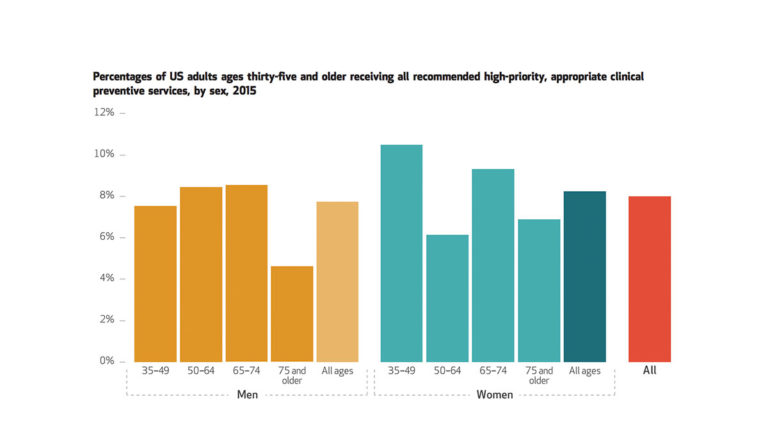Preventive Care Deficit
Only 8% of surveyed adults age 35 and older received all recommended high-priority clinical preventive services.

Read Time: 2 minutes
Published:
According to the Centers for Disease Control and Prevention, seven out of ten Americans die from chronic diseases like diabetes, heart disease, and cancer. Costs associated with using preventive services may deter people from getting screened for these conditions. Globally, other industrialized countries have fewer financial barriers to prenatal, pediatric, and other types of primary care.
Routine primary health care is critical to preventing or identifying illness in early stages when it can be treated. It has also been a core objective of population health since the 1978 Alma Ata Health for All Declaration. But research on the use of such care in the United States has focused on specific services like colorectal cancer screening and flu vaccination. Borsky et al. developed a new, more comprehensive method to measure how many adults use the high priority preventive services recommended for them. Their survey asks participants about fifteen types of evidence-based, clinically relevant preventive care, and accounted for inappropriate use and overuse.
The figure shows that, as of 2015, only 8% of all adults age 35 and older received all recommended high-priority clinical preventive services. This measure reflects the survey’s assessment of multiple types of preventive care. Taking a deeper look, Borsky and colleagues found 22.4% of surveyed adults received at least 76% of the recommended care. Compared to women, men were more likely to receive up to 25% of suggested preventive care services. Only 4.7% of all participants did not receive any recommended services. Blood pressure screenings were most commonly received, and shingles vaccinations least.
The researchers argue that the comprehensive nature of their survey instrument will be useful for health systems to assess the preventive services they offer and their receipt. They also emphasize that their questionnaire can be used at both the national and practice-specific level to help identify the impact of changes to local and national policy on preventive service use.
Databyte via Amanda Borsky, Chunliu Zhan, Therese Miller, Quyen Ngo-Metzger, Arlene S. Bierman, and David Meyers, Few Americans Receive All High-Priority, Appropriate Clinical Preventive Services. Health Affairs.



